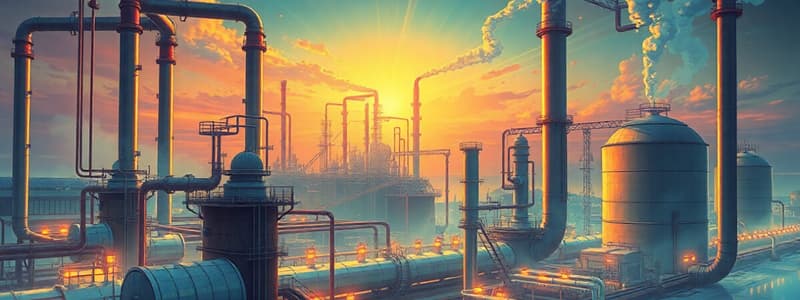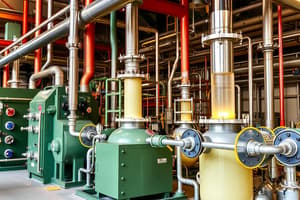Podcast
Questions and Answers
What is the molecular weight of ammonia?
What is the molecular weight of ammonia?
- 17 gm/mol (correct)
- 18 gm/mol
- 20 gm/mol
- 14 gm/mol
Ammonia has a boiling point of -33.34 ˚C.
Ammonia has a boiling point of -33.34 ˚C.
True (A)
Name one industrial use of ammonia in the fertilizer industry.
Name one industrial use of ammonia in the fertilizer industry.
Fertilizer production
The Haber-Bosch process produces ammonia through the reaction of nitrogen gas and __________.
The Haber-Bosch process produces ammonia through the reaction of nitrogen gas and __________.
Match the following properties of ammonia with their values:
Match the following properties of ammonia with their values:
What catalyst is used in the Haber process?
What catalyst is used in the Haber process?
Higher pressure decreases the yield of the Haber process.
Higher pressure decreases the yield of the Haber process.
What is the heat of formation for ammonia?
What is the heat of formation for ammonia?
According to Le Chatelier's principle, what conditions favor the formation of NH3 in an exothermic reaction?
According to Le Chatelier's principle, what conditions favor the formation of NH3 in an exothermic reaction?
The ammonia synthesis reaction is endothermic.
The ammonia synthesis reaction is endothermic.
What is added to the catalyst based on FeO to improve its performance?
What is added to the catalyst based on FeO to improve its performance?
The synthetic ammonia process uses _______ as the primary source of hydrogen.
The synthetic ammonia process uses _______ as the primary source of hydrogen.
Match the stages of the Braun Purifier Process with their purposes:
Match the stages of the Braun Purifier Process with their purposes:
What is the typical pressure for ammonia synthesis?
What is the typical pressure for ammonia synthesis?
The shift reactors convert carbon monoxide to carbon dioxide in the ammonia synthesis process.
The shift reactors convert carbon monoxide to carbon dioxide in the ammonia synthesis process.
What is the main reaction in the ammonia synthesis process?
What is the main reaction in the ammonia synthesis process?
Flashcards
Haber-Bosch Process
Haber-Bosch Process
The industrial process for synthesizing ammonia from nitrogen and hydrogen gas.
Nitrogen and Hydrogen reaction to form Ammonia
Nitrogen and Hydrogen reaction to form Ammonia
A chemical reaction where nitrogen gas and hydrogen gas react to form ammonia. This process is exothermic, meaning it releases heat.
Iron catalyst in Haber-Bosch
Iron catalyst in Haber-Bosch
A crucial component of the Haber-Bosch process, iron is used to accelerate the reaction rate and allows for a lower temperature, which increases the yield of ammonia.
Solubility of Ammonia
Solubility of Ammonia
Signup and view all the flashcards
Braun Purifier Process
Braun Purifier Process
Signup and view all the flashcards
Boiling point of Ammonia
Boiling point of Ammonia
Signup and view all the flashcards
Freezing point of Ammonia
Freezing point of Ammonia
Signup and view all the flashcards
Standard heat of formation of Ammonia
Standard heat of formation of Ammonia
Signup and view all the flashcards
What is chemical equilibrium?
What is chemical equilibrium?
Signup and view all the flashcards
What is Le Chatelier's Principle?
What is Le Chatelier's Principle?
Signup and view all the flashcards
How does pressure and temperature affect the equilibrium yield of ammonia (NH3)?
How does pressure and temperature affect the equilibrium yield of ammonia (NH3)?
Signup and view all the flashcards
What is a catalyst and what catalyst is used in ammonia synthesis?
What is a catalyst and what catalyst is used in ammonia synthesis?
Signup and view all the flashcards
What are promoters and what are they used for in ammonia synthesis?
What are promoters and what are they used for in ammonia synthesis?
Signup and view all the flashcards
What is the Braun Purifier Process?
What is the Braun Purifier Process?
Signup and view all the flashcards
What is purification in the context of ammonia synthesis?
What is purification in the context of ammonia synthesis?
Signup and view all the flashcards
What is steam reforming in the context of ammonia synthesis?
What is steam reforming in the context of ammonia synthesis?
Signup and view all the flashcards
Study Notes
Industrial Chemistry 1: Chapter 4 - Ammonia Production
- Ammonia production is a vital industrial process, used in fertilizers, petroleum, mining, rubber, paper, and leather industries, as well as medicine and cosmetics.
Properties of Ammonia
- Molecular weight: 17 gm/mol
- Boiling point: -33.34 °C
- Freezing point: -77.7 °C
- Standard heat of formation: -46222 KJ/Kmol
- Soluble in chloroform, ether, and ethanol.
- Density: 0.769 Kg/m³ at STP
Uses of Ammonia
- Refrigerant
- Medicine & Cosmetics
- Solvent
- Lab reagent
- Metal treatment
- Preservative
- Transport of H₂
Uses of Ammonia In Industries
- Fertilizer Industry
- Petroleum
- Industry Mining
- Industry Rubber
- Industry Paper
- Industry Leather
Manufacturing Processes
- Synthesis gas for ammonia production is achieved via steam reforming or partial oxidation of hydrocarbon feedstock.
- Commercially used ammonia production processes include:
- Haber-Bosch Process
- Braun Purifier Process
1. Haber-Bosch Process
- The industrial implementation of the reaction between nitrogen gas and hydrogen gas.
- Main industrial procedure for ammonia production.
- Reaction: N₂ + 3H₂ → 2NH₃ (ΔH = -92.4 kJ·mol⁻¹)
Flow Scheme of Haber Process
- Nitrogen from the air and hydrogen from natural gas (1:3 volume ratio)
- Reacted at 400-450°C and 200 atm pressure using an iron catalyst.
- Unreacted gases are recycled.
- Gases are cooled to liquefy the ammonia.
Process Flow Diagram
- Details of the process steps, showing various steps including the production of the synthesis mixture, using methane as a feedstock, and the production of ammonia. The diagram outlines the reaction steps, heat exchangers, and other components.
Parameters
- Temperature: 450°C (moderately high); Lower temp increases equilibrium yield but reactions are too slow.
- Pressure: 200-1000 atm; High pressure is beneficial for rate and equilibrium position.
- Catalyst: Iron; catalyst increases reaction rate, allowing for lower temperature.
- The Haber process is exothermic in the forward direction (N₂ + 3H₂ ↔ 2NH₃ + Heat)
Major Engineering
- Reaction kinetics and equilibrium: Lower temperature favors the forward reaction, and higher pressure is favorable for decreasing moles.
- Graph (1) & (2): Equilibrium yield of NH₃ is increased by increasing the pressure and decreasing the temperature.
Catalyst
- Primarily based on FeO.
- Modern catalysts include promoters like oxides of Al, Zr, and K, to enhance porosity and withstand high temperatures.
2. Braun Purifier Process
- Synthetic ammonia (NH₃) is produced from natural gas.
- Natural gas molecules are converted to hydrogen.
- Hydrogen is purified and reacted with nitrogen.
Chemical Processes
- Description of the chemical processes involved in ammonia synthesis from natural gas, including hydrodesulphurization, primary and secondary reforming, high temperature/low temperature shift, CO₂ removal, methanation, and intermediate processes.
Simple Block Diagram
- Shows a schematic of the ammonia production process, outlining the various catalyst types and volumes involved.
- Includes temperatures and pressures at each stage, outlining primary reforming, secondary reforming, High/Low Temperature CO Shifts, CO removal, and methanation stages.
Simplified Process Overview (Pages 15 and 16)
- Purification of impurities (mainly sulfur compounds) from the gas stream.
- Steam reforming in two stages:
- Primary stage: Endothermic reactions at high temperatures (800°C+) and pressures (~30 bar).
- Secondary stage: Addition of air to the partially reformed gas and an exothermic reaction.
- Conversion of carbon monoxide to carbon dioxide in the shift reactors, followed by removal.
- Any residual carbon oxides are converted back to methane by methanation before compression.
- Final stage: The reaction of hydrogen and nitrogen to form ammonia at high pressures (100-350 bar). This reaction is highly exothermic.
- Reactor Types (Page 18): Presents different ammonia synthesis reactor types, their cooling methods, and corresponding companies or licensors. Includes pressure and production capacity data.
Reactor for Ammonia Synthesis
- Diagrams of different ammonia reactor designs (Kellogg and Topsoe).
Studying That Suits You
Use AI to generate personalized quizzes and flashcards to suit your learning preferences.




